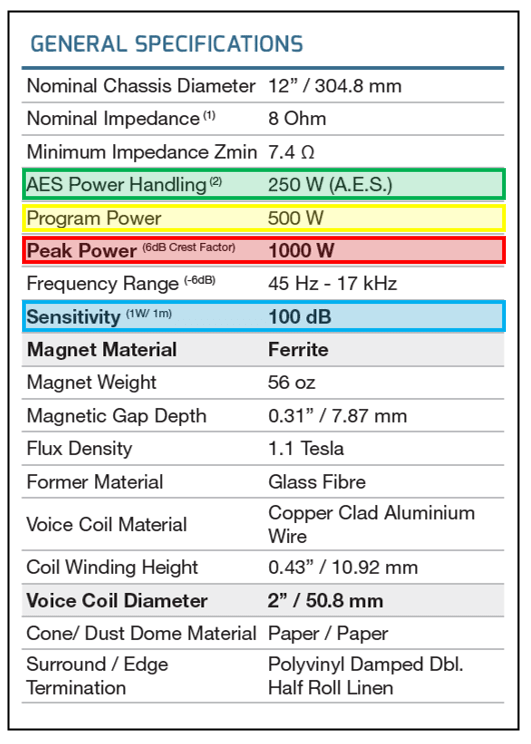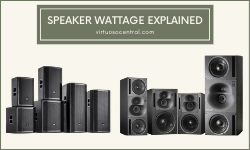It seems that there is a misunderstanding between the wattage of a speaker and the volume it outputs. Many people believe that if a loudspeaker can handle a higher number of watts, as a consequence, the sound level should be higher, but that is not entirely true.
In this post, I will explain speaker wattage, what it means, and some other essential concepts that will help you understand the specifications of a loudspeaker. Let’s get started.
Speaker Wattage Ratings Explained
Speaker wattage is the electrical power handling capabilities that a speaker can receive from an amplifier. When you look and the back of a speaker, you’ll see in the label the number of watts the speaker can handle. This measure only tells you the power requirements at which a speaker can operate, not the output volume.
There are two leading power figures used by manufacturers to describe a speaker’s capabilities, the nominal power, and peak power. Another rating used by some manufacturers is program power that one tends to be confusing. Let’s take a look at each one.
Nominal Power in Speakers
The nominal power rating in a speaker is the amount of power a speaker can handle from an amplifier continuously without being damaged. It is also known as the RMS power (root mean square). This is an essential rating you need to keep in mind when matching speakers to amplifiers.
Peak Power in Speakers
Speaker specifications also include the peak power rating of a loudspeaker. Peak power refers to the absolute maximum power a speaker can handle for a short time. In other words, it’s the maximum wattage a speaker can consume in short bursts without being damaged.
When it comes to speakers, the peak power is calculated by multiplying the nominal or RMS power by 4, RMS x 4.
Sometimes speaker manufacturers use peak power to advertise their products. That practice is misleading because customers would think that the speaker is more powerful than what it is in reality.
Program Power in Speakers
Program power and peak power are very similar in their definition because both refer to the maximum power a speaker handles in short bursts of sound. Examples of short bursts are if an open mic falls to the floor, swift feedback, or connecting a guitar cable with the channel being on.
Program power is twice the RMS or nominal power, RMS x 2. The program power rating is not as common as peak power but is still used by several speaker manufacturers.
What is AES in Speaker Specifications
AES stands for “Audio Engineering Society,” and it is an organization that sets standards for the audio community. One of the criteria that they have set is how to measure RMS power in loudspeaker components.
The AES RMS power is measured using pink noise at specific dynamics and frequency range that matches the component’s designed characteristics. The test is carried for 2 hours until the frequency content matches the component’s frequency range.
The nominal or RMS AES power specification that you find in a speakers’ datasheet corresponds to the measured average RMS power of the components frequency range.

What to Consider When Choosing a Speaker
Both ratings, nominal and peak power are essential for correctly matching speakers to amplifiers. Make sure always to check the specs to find the continuous or nominal power of the loudspeaker, because it is the base reference for correctly choosing an amp.
You would also need to know the sensitivity (sound pressure level SPL), measured in dB, and the coil’s impedance.
Don’t Confuse Wattage with Output Volume
It is often believed that the higher the wattage of a speaker, the louder it is, but this is not necessarily the case. As explained above, wattage only tells you the power a speaker can handle, and this measure doesn’t translate in output volume. When selecting a speaker, you need to look for how well it performs and not how much power it consumes.
To know how well a speaker performs, you need to look for the sensitivity of the speaker. One of the specs on the datasheet is the speaker’s sensitivity, and it refers to the perceived loudness relative to distance. It is measured in dB (decibels).
Refer to the previous image, the one highlighted in red is the speaker’s sensitivity or SPL (Sound Pressure Level). We have a post dedicated to explaining in more detail the meaning of SPL and what it means in audio, click the link to read more about it.
By doubling the power of the amp and the speaker, loudness is increased by only 3dB. To double the loudness, you need 10 times the power. In other words, a 10dB increase in SPL translates to doubling the loudness of a system.
For example, to double the loudness of a 100W system, you would need 1000W, and this would only increase the SPL by 10dB. This is why it is vital to take into consideration all of these aspects when choosing speakers and amplifiers.
Final Thoughts
Speakers are not as efficient for transferring electrical power into acoustic power; a lot the energy is wasted as heat. This is why it is vital to not only care about how many watts it can handle but how efficient it is. I hope that this article helped you to get a better understanding of speaker wattage.
